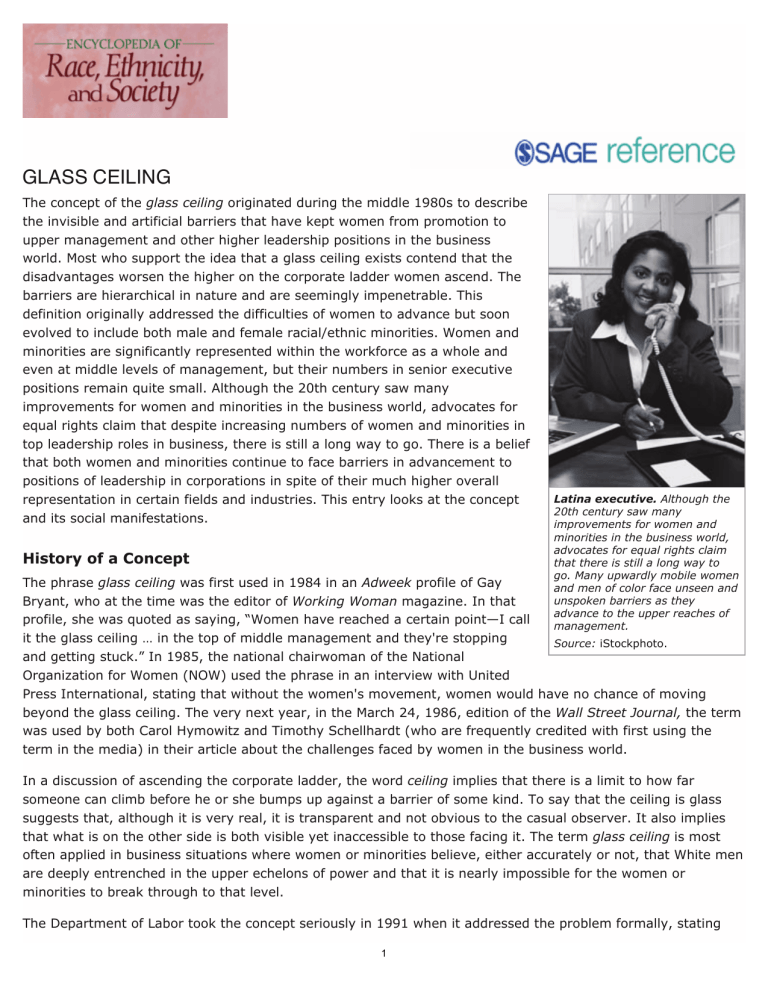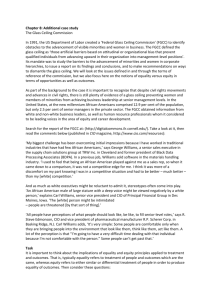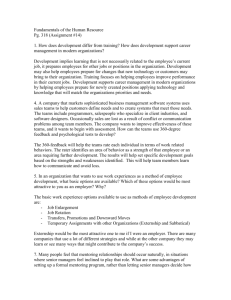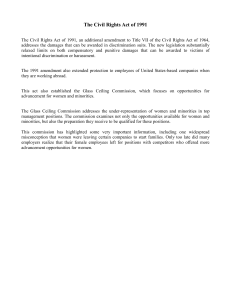
GLASS CEILING The concept of the glass ceiling originated during the middle 1980s to describe the invisible and artificial barriers that have kept women from promotion to upper management and other higher leadership positions in the business world. Most who support the idea that a glass ceiling exists contend that the disadvantages worsen the higher on the corporate ladder women ascend. The barriers are hierarchical in nature and are seemingly impenetrable. This definition originally addressed the difficulties of women to advance but soon evolved to include both male and female racial/ethnic minorities. Women and minorities are significantly represented within the workforce as a whole and even at middle levels of management, but their numbers in senior executive positions remain quite small. Although the 20th century saw many improvements for women and minorities in the business world, advocates for equal rights claim that despite increasing numbers of women and minorities in top leadership roles in business, there is still a long way to go. There is a belief that both women and minorities continue to face barriers in advancement to positions of leadership in corporations in spite of their much higher overall representation in certain fields and industries. This entry looks at the concept and its social manifestations. History of a Concept Latina executive. Although the 20th century saw many improvements for women and minorities in the business world, advocates for equal rights claim that there is still a long way to go. Many upwardly mobile women and men of color face unseen and unspoken barriers as they advance to the upper reaches of management. The phrase glass ceiling was first used in 1984 in an Adweek profile of Gay Bryant, who at the time was the editor of Working Woman magazine. In that profile, she was quoted as saying, “Women have reached a certain point—I call it the glass ceiling … in the top of middle management and they're stopping Source: iStockphoto. and getting stuck.” In 1985, the national chairwoman of the National Organization for Women (NOW) used the phrase in an interview with United Press International, stating that without the women's movement, women would have no chance of moving beyond the glass ceiling. The very next year, in the March 24, 1986, edition of the Wall Street Journal, the term was used by both Carol Hymowitz and Timothy Schellhardt (who are frequently credited with first using the term in the media) in their article about the challenges faced by women in the business world. In a discussion of ascending the corporate ladder, the word ceiling implies that there is a limit to how far someone can climb before he or she bumps up against a barrier of some kind. To say that the ceiling is glass suggests that, although it is very real, it is transparent and not obvious to the casual observer. It also implies that what is on the other side is both visible yet inaccessible to those facing it. The term glass ceiling is most often applied in business situations where women or minorities believe, either accurately or not, that White men are deeply entrenched in the upper echelons of power and that it is nearly impossible for the women or minorities to break through to that level. The Department of Labor took the concept seriously in 1991 when it addressed the problem formally, stating 1 that a glass ceiling is made up of “artificial barriers based on attitudinal or organizational bias that prevent qualified individuals from advancing upward in their organization into management-level positions.” Senator Robert Dole introduced the Glass Ceiling Act as part of Title II of the Civil Rights Act of 1991. President George H. W. Bush signed the Civil Rights Act of 1991 and established a bipartisan Glass Ceiling Commission composed of twenty-one members. The commission was tasked with forming recommendations on the issue for the president and leaders in the corporate world. In 1991, Secretary of Labor Lynn Martin completed the Glass Ceiling Initiative Report, which confirmed the existence of the invisible artificial barriers that blocked women and minorities from advancing up the corporate ladder to management- and executive-level positions. Robert Reich, chairperson of the Glass Ceiling Commission, stated that this “ceiling” was a refutation of social justice for a large portion of the population. He also saw it as a problem that has negatively affected American business by hindering some of the most qualified applicants from important positions of power simply because of their race or gender. The report revealed that although women made up nearly 46% of the total workforce at the time and earned more than half of all master's degrees, 95% of senior-level managers were men and the earnings of female managers accounted for less than 70% of their male manager counterparts. During the decade since the commission's report, things have improved somewhat in that women managers now earn an average of 72% of their male colleagues' salaries. Male and female minorities were less well represented in management. After the Civil Rights Act of 1954 and the introduction of affirmative action during the mid-1960s, legal barriers to their hiring and promotion were removed, yet their representation in the higher echelons of business was a fraction of their overall presence in the labor force. Some see this as proof of the existence of a split labor market in which racial/ethnic minorities receive lower remuneration than do Whites and are unable to get even entry-level positions in industries that have been long dominated by Whites, White males in particular. In 1990, the proportion of minorities in top management positions was less than 1%, and their earnings lagged far behind even those of their White female colleagues. Although most scholars of inequality agree that the concept of the glass ceiling refers to the lack of access to the most highly paid corporate positions, many others use this term to describe gender or race discrimination at all levels of the business world. This concept has been adapted to address barriers to women in specific industries such as the stained glass ceiling to describe the difficulty women have had in ascending to the highest levels of the ministry, the grass ceiling when examining the dearth of women in agriculture-related industries, and the political glass ceiling that bemoans the slow pace of women's advances in the political realm. In the world of academia, the combined effects of a glass ceiling and a maternal wall are thought to interact to hinder women's advancement in the ivory tower because of choices made in relation to child-bearing and child-rearing responsibilities. Another variation is the glass cliff, which refers to a woman in a position that may put her in the precarious position of professional disaster if she fails. Whereas the aforementioned concepts refer to the difficulties that women and minorities face in making inroads into the higher echelons of male-dominated industries, another concept, the glass elevator or escalator, refers to the relative ease and rapid advancement that men have in achieving promotions to management in femaledominated industries such as nursing and teaching. Cracking the Glass Ceiling Although many continue to insist that the glass ceiling is a real barrier for women and minorities in accessing male-dominated positions in business, others challenge that assertion. They say that the glass ceiling continues to exist primarily because of choices made by women regarding the time they spend on their families that, in the end, limits the time they need to advance in their careers. The cumulative effect of time off for child bearing and child rearing is blamed for women facing lower wages and delayed advancement to the highest positions. 2 Contrary to claims of continuing inequality or discrimination, critics of the glass ceiling concept place the blame for the underrepre-sentation of women in particular, and of minorities by association, on the individuals themselves and on considerations other than structural or institutional inequality. Nevertheless, industries such as the investment world have suffered criticism about past sexism, with legal judgments levied against Morgan Stanley and Merrill Lynch for practices deemed to be discriminatory. Recently, the investment industry has made inroads into the recruitment and training of women for top positions in their firms to address their past misdeeds. Changes are slow, however; although women currently represent 33% of the best in the bank analyst classes of business schools, only 25% of newly hired associates in this same industry are women. Only 14% of the top executives in the banking industry are women, and in 2005 one report showed that women make 77 cents for every dollar men make. However, many say that improvement, no matter how small, shows that there are cracks developing in the glass ceiling. Landmarks in Cracking the Glass Ceiling In 2004, it was estimated that in the United States, women earned 77 cents for every dollar men earn. Although this is a slight increase from 74 cents during the mid-1990s and is up from 68 cents during the late 1980s, these numbers remain troubling to many proponents of equal rights and equal opportunities. Women and minorities are making inroads into higher echelons of the business world, but their salaries still lag behind those of their male counterparts. Although the overall picture remains discouraging, there are clear examples of individuals who have beaten the odds and made the glass ceiling seem permeable. In 1962, Harvey C. Russell became the first Black vice president of a Fortune 500 company, PepsiCo. During this very volatile time in U.S. history, the promotion of an African American was very controversial, prompting the Ku Klux Klan to attempt to organize a boycott using handbills informing customers that buying Pepsi products would make Black people rich. PepsiCo has continued to be instrumental in lowering the barriers throughout its history by featuring minorities in their advertising and by not hindering their advancement up the corporate ladder. A recent example was the hiring of Indra Nooyi, the eleventh woman to ascend to the top leadership position in a Fortune 500 company. Although women in upper management are becoming more visible, they still account for less than 17% of all corporate officer jobs, with women of color accounting for less than 2% of that number. Some notable examples of those pioneers are Carleton Fiorina, who in 1999 became the first female chief executive officer (CEO) of a Fortune 500 company, Hewlett-Packard. Her tenure ended amid controversy in 2006, but her appointment seemed to widen the crack in the glass ceiling that had kept women from the top jobs. Just during the past couple of years, Irene Rosenfeld took over the helm of Kraft Foods and Patricia Woertz became CEO of ArcherDaniels-Midland. Consistently at the top of the Forbes 400 list of richest Americans are those who have moved beyond the barriers whether they be in place due to gender or race. Oprah Winfrey is a self-made success story who not only has moved beyond the glass ceiling of gender and race but also has taken countless others with her. Although women and minorities are still struggling for parity among their primarily White male counterparts, there are definitely examples that challenge the idea that these discriminatory practices are enmeshed in corporate culture. —Karen S. Boyd Further Readings Blau, Francine D. , ed. , Mary C. Brinton , ed. , and David Grusky , eds. 2006. The Declining Significance of Gender. New York: Russell Sage. 3 Federal Glass Ceiling Commission. 1995. Good for Business: Making Full Use of the Nation's Resources. Washington, DC: Government Printing Office. Hymowitz, Carol and Timothy D. Schellhardt “The Glass Ceiling: Why Women Can't Seem to Break the Invisible Barrier That Blocks Them from the Top Jobs.” The Wall Street Journal. no. March 24 1986. pp. 1. Maume, David J. “Is the Glass Ceiling a Unique Form of Inequality? Evidence from a Random-Effects Model of Managerial Attainment.” Work and Occupations vol. 31 2004. pp. 250–274. Entry Citation: Boyd, Karen S. "GLASS CEILING." Encyclopedia of Race, Ethnicity, and Society. Ed. . Thousand Oaks, CA: SAGE, 2008. 549-52. SAGE Reference Online. Web. 30 Jan. 2012. © SAGE Publications, Inc. Brought to you by: SAGE 4





